
The Stellar Community Fund (SCF) and its predecessor, the Stellar Build Challenge (SBC), have supported Stellar-based businesses and developers since 2016. This makes the fund one of the oldest in the blockchain industry! In this time, we’ve had nearly 400 winners and funded almost 200M XLM, Stellar’s native asset, based on community input. And that last part is what makes the SCF so special: not only do projects get a chance to win funding, but they also receive helpful feedback and support from the community, make invaluable connections, and acquire a sense of belonging with the Stellar ecosystem. It sets projects up for further growth and fuels community engagement, which is why so much has been invested in the fund for over six years.
SCF’s history is expansive. And we’ve learned a lot along the way. Read on to discover how SCF has developed since its inception, the colorful ideas we’ve implemented (and for some, removed soon after), and what’s in store for the future.
This blog post is a copy of the original resource residing in the SCF Handbook.
SCF total stats
Throughout the years, SCF has been iterated on many times based on community feedback. To discover when, how, and why the fund evolved, we took a ride on the WayBackMachine and dug into some ancient blog posts and Reddit threads. We’ll talk about the details later on, but here are some key takeaways:
- SBC 1–3: No-strings-attached funding for projects is a successful method to grow the Stellar ecosystem with long-lasting developers, community members, and companies.
- SBC 4: An interactive format where projects can solicit feedback from SDF and the community before final voting increases the quality of submissions.
- SBC 6: Project submissions are influenced by the (crypto) market. There needs to be flexibility in the availability of reviewers and in the prize pool to ensure we can support projects, no matter what the market does.
- SBC 7: SBC isn’t meant to sustain projects or developers long-term. Instead of focusing on resubmissions, we need to support new projects and products.
- SBC 7 — SCF 1: Having the community decide which projects receive funding makes community members feel valued and decentralizes decision-making.
- SCF 1–5: Allowing anyone with internet access to vote increases the likelihood of voter manipulation, even with sophisticated voting mechanisms in place.
- SCF 5–6: SCF has two main audiences, each with a distinct goal for funding: 1) full-fledged companies interested in kick-starting development on Stellar, and 2) community developers who want funding for smaller, more experimental projects. Both are valuable but require different amounts of funding.
- SCF 6–7: Splitting the fund into two separate programs, the Lab Fund and the Seed Fund, confused submitters. Most just applied for the first one available.
- SCF 6–7: Using quadratic flaggable voting did a better job reflecting community sentiment but did nothing to prevent voter manipulation. Also, many found the system to be confusing.
- SCF 6–8: Allowing the entire world to vote doesn’t achieve the purpose of SCF, as most voters are friends, family, or bots. To reach a fair and decentralized voting process, voters should be part of the Stellar community and not be tied to any particular submission.
- SCF 8: Using a selection process to filter the initial submissions to 30–40 projects is crucial to make reviewing and voting manageable.
- SCF 8: Instead of relying on the community to allocate funding amounts, it’s better to have each project request a budget that matches their project’s scope.
- SCF 8: Moving from Keybase to Discord successfully opened up access to and grew the community.
- SCF 8–9: A more extensive application doesn’t deter serious applicants from submitting. Instead, it helps them think more deeply about their submission and shapes the project in a positive way.
- SCF 9–10: Bootcamps are a successful way to get high-quality entries into the SCF, though it’s difficult for them to get popularity with the voters as separate programs.
- SCF 9–10: SCF unlocks opportunities for continued development and growth. Submitters want to connect with SDF for additional grants and support as well as work with external accelerators, incubators, and investors.
- SCF 10: Having candidates present demos at a dedicated time before voting increases community engagement and eases voter review.
- SCF 10: There is a need for guidance materials and rules to prevent ineligible entries from submitting and direct eligible submissions in the right direction.
- SCF 10: The community expressed interest in having a more decentralized governance structure for voting and the selection phase. Voters also wanted more involvement opportunities.
Where it all began: the Stellar Build Challenge
On June 28, 2016, the Stellar Development Foundation (consisting of only a handful of people) announced the Stellar Build Challenge, a new program that awarded 2B+ XLM to encourage creativity and develop the Stellar ecosystem.
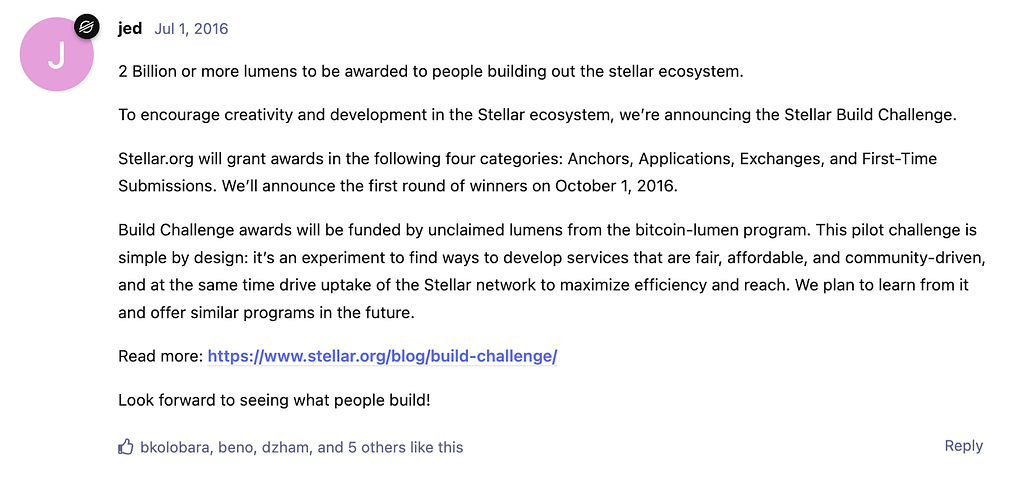
Developers were encouraged to submit projects in one of four categories: anchors, applications, exchanges, or first-time submissions, with awards distributed annually or quarterly depending on the category. After the pilot’s submission period ended in October 2016, a panel of judges consisting of SDF members and the Stellar community voted for their favorite projects. Of the 40 projects submitted (at a time when the ecosystem was virtually non-existent), 20 projects received a total of 62,400,000 XLM! That seems like a huge amount now, but at the time this article was written, the lumen was only worth fractions of a cent and ended up being worth around $169K. Still not a bad payday!
The second and third SBCs built on the pilot’s success. SBC #2 ended in February 2017 and received 47 submissions, 40 of which were awarded 50M XLM. SBC #3 ended in May 2017, with 16 submissions receiving 30.5M XLM.
SBC was no longer an experiment but a thriving program working to grow the Stellar ecosystem. Many winners from this period are still in the ecosystem today, including OrbitLens (who later started stellar.expert), Tempo Money Transfer, a digital money transfer company issuing EURT on Stellar and one of the first Stellar anchors, Rehive a white-label fintech app builder, and Lobstr, one of the most popular Stellar wallets to date.
SBC #4 + #5 — The age of GalacticTalk
GalacticTalk started as a forum to organize discussions better than the Stellar Slack channel (where the community gathered before Keybase and Discord), and was an immediate hit with the community: Jed himself even used it to announce the first SBC.
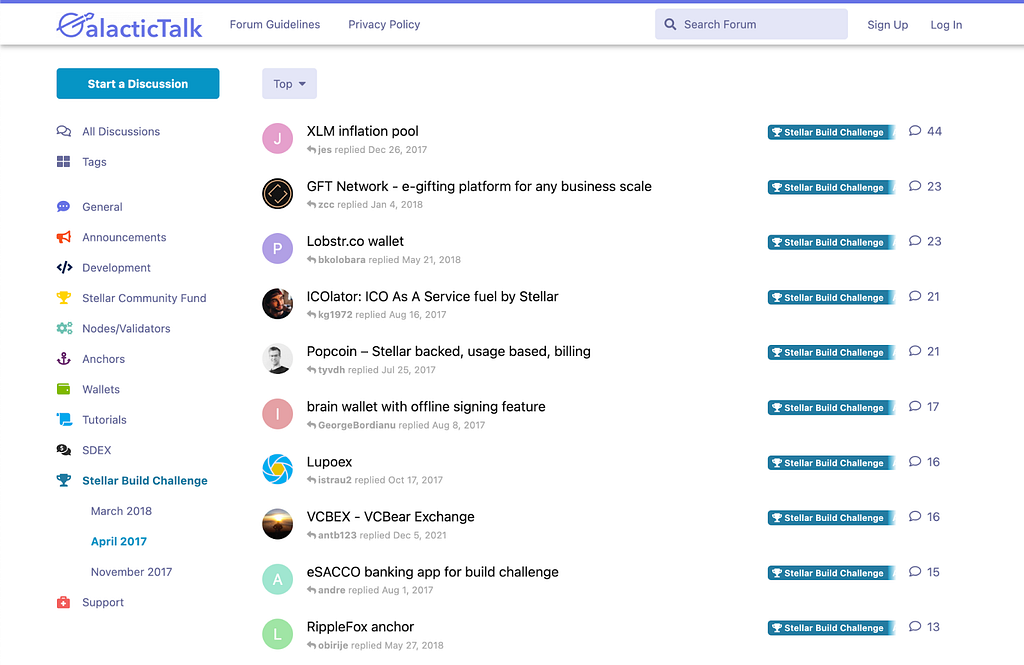
During the fourth round of SBC starting in May 2017, we started listing submissions on GalacticTalk. This allowed applicants to solicit feedback from SDF and the community before uploading their final projects for review. With this new interactive format, SBC #4 reeled in 45 submissions, of which the judges awarded 23 winners with 7.95M XLM.
Well known Stellar ecosystem players including StellarTerm and Chipper Cash got their start in this round. Also, one of the winners was PopCoin, the first ever Stellar project of Tyler van der Hoeven — then an avid community member, now SDF’s very own Ecosystem Engineer spearheading smart contract functionality on Stellar. Who would have thought?!
During the 5th round of the Stellar Build Challenge, 50 projects were submitted, of which 35 winners were awarded a total of 5.7M XLM. SBC #5 saw the birth of stellar.expert, currently the most used ledger and statistics explorer for the Stellar network. Also, lumen support was added on the Ledger Nano S, which was the first time a Stellar asset had hardware wallet support.
SBC #6 + #7 — The turn of an era (or was it?)
XLM hit its all-time high to date on Jan 04, 2018. There was suddenly a much higher interest in the Stellar network, and we saw this reflected in SBC #6. 324 projects were submitted to this round, more than all the other previous SBCs combined! 113 winners were awarded 2.7M XLM, five times the prize pool of the previously planned 550K. Among the high-quality entries were popular SDKs Stellar’s Python SDK and Stellar iOS SDK, Stellar node explorer, StellarBeat, and Stellar educational platform Lumenauts.com.
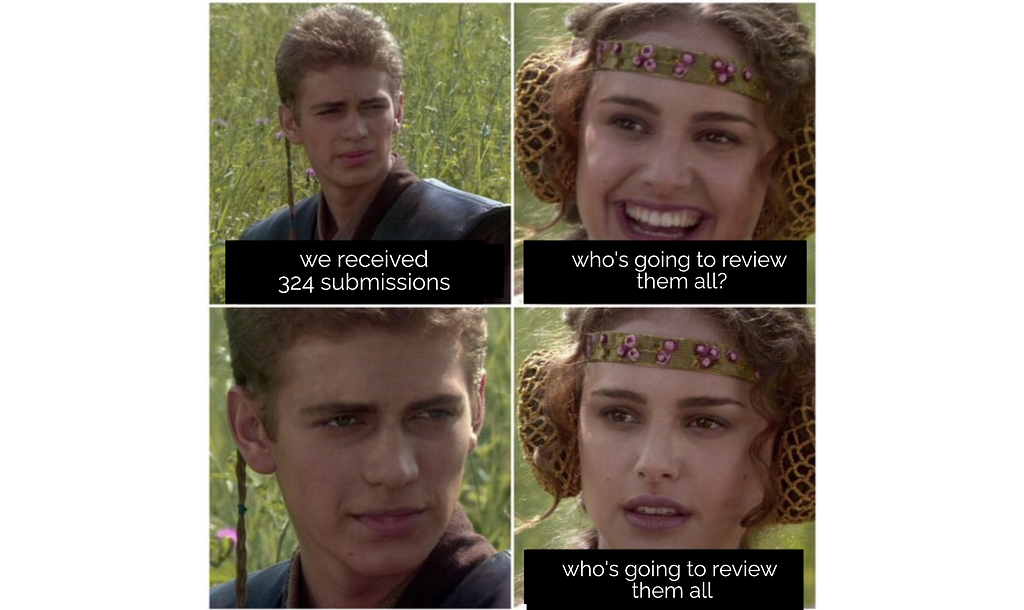
While the increased number of submissions was great, we struggled to keep up with the demand. There was only one person to handle the initial review rounds, with Jed McCaleb making the final decisions. As the blog post announcing the results indicates:
“Confusion. Disorder. Darkness. Without form. Without meaning…Then, suddenly, from chaos, order. Behold! Obey!”
Encountering these scalability problems forced SBC to shift strategies. During the seventh and last iteration of SBC, some major changes were introduced to bring back the spirit of community and collaboration. Changes included:
- In previous rounds, applicants could resubmit their project every round to receive ongoing support. As SBC was found not to be a great framework for this, SDF decided to support previous winners outside of SBC.
- That said, developers were allowed to submit new contributions to ongoing and meaningful open-source projects such as SDKs, wallets or exchanges, and ledger explorers (many of which originally supported through SBC).
- Developers were encouraged to directly collaborate with SDF to build one of four new project ideas: a better quorum explorer, a trade bot maker, social trading, or a peer-to-peer wallet. SDF’s own Zac Freundt joined the panel to judge submissions, with final decisions still made by Jed McCaleb.
- Since discussion was helpful for projects, SDF expressed plans to start rewarding users who gave productive feedback on GalacticTalk and GitHub.
SBC #7’s results weren’t disappointing: out of 107 submissions for open-source project contributions, 53 received awards totaling 1.62M XLM. In addition, 1.9M XLM was awarded through the new support initiative that encouraged growth and development for cornerstone projects, which later turned into SDF’s Infrastructure Grant to support projects that provide crucial network utility.
Transitioning from SBC to SCF
Many of SBC’s winning projects became foundational to the Stellar ecosystem, making the program essential to driving network growth. However, there was one request the community expressed several times that ultimately led to the shift from SBC to SCF: community participation in guiding lumen distribution, which was not possible with how SBC was structured. At the end of 2018, the Stellar Community Fund (SCF) was announced with the goal of using community input to award high-value projects. And that remains our goal today!
While it did turn out that way, SCF was not originally designed to be a replacement for SBC. As all kinds of projects could be submitted to SCF, there was a desire to have a more bounty-style developer-focused program as an iteration on SBC, and the two programs were meant to be partners. While we have several developer support programs now, at the time there was insufficient bandwidth to pursue them, and only SCF prevailed.
The SCF planned to distribute 12,000,000 XLM each year through quarterly rounds (3M XLM for each round), starting with the first round on April 17, 2019 as a beta test. From the beginning, we expected SCF to evolve significantly, and invited the community to help shape future rounds. Similar to SBC, submissions lived on GalacticTalk, but in contrast, SCF invited developers to submit all kinds of proposals, including applications, tools, content, and events, as long as they weren’t just a proof-of-concept. Also, a channel to host general discussion was created on Keybase, a secure messaging and file-sharing platform with a Stellar wallet supported by SDF since March 2018.
Now here’s where it got really interesting: SCF introduced community voting. Voting took place in two phases: 1) the Nomination phase, and 2) the Award phase. Existing community members could ‘like’ proposals on GalacticTalk, where the seven most liked proposals were nominated. To prevent voter manipulation, new accounts could not participate in the current round and had to wait for the next one.
After getting nominated, the seven projects of the first SCF round moved to the Award phase: a week-long festivity on a poll thread of /r/Stellar. Users could vote by selecting one of the seven options in the poll and leaving a comment confirming the project they were voting for. After one week, votes were counted, and winners were awarded proportionally based on final vote percentages.
With this new design, an unprecedented problem arose that would heavily influence future iterations of SCF: voter manipulation. Reddit was not designed to prevent anyone from manipulating votes which opened the door for bad actors to set up sock puppet accounts and farm votes. In the end, the votes of 142 eligible unique individuals were taken into account to distribute the first 3M XLM of the Stellar Community Fund.
Originally, there were plans to have a delegate-based voting system (also referred to as liquid democracy) instead of the more open approach described above. Similar to political democracy, the community would delegate their votes to trusted experts of their choice (delegates) to sort through proposals and award based on their determinations. Delegates would have been given a pool of XLM to use during a six-month cycle (to give sufficient time for the amount of effort it would take) and when it was depleted — no new grants could be given out. The benefits of this voting mechanism are that not everyone needs to vote, and it’s likely that better and more informed decisions will be made in the best interest of the ecosystem. However, after much feedback and internal discussion, this system wasn’t adopted. Some of the major issues with the original concept were:
1. In delegated systems, bribery and corruption could manipulate decision-making which breeds claims of conspiracy.
2. It puts a lot of pressure on delegates: they would need to campaign for votes, and the community can easily become fractured on which side to pick.
3. There weren’t enough people up for the task, so there wouldn’t have been enough rotation between delegates.
4. Delegates would need to budget their pool over the 6-month cycle, which may lead to inconsistent awards. This would confuse submitters as they would have no idea of what to expect for their effort.
SCF #2 + #3 + #4 — New voting mechanism
In SCF #2, previous SBC winner Tyler van der Hoeven joined SDF and came to the rescue. He ingeniously designed a custom voting interface with an algorithm that prevented users from farming votes. Instead of voting on a poll with a Reddit account, you needed a Keybase account where you clicked on a confirmation link to complete the sign-in process, which needed to be done by an actual human.
SCF #2 saw eight winners out of the 38 projects submitted and had a total of 415 eligible unique voters. Lobstr, arguably one of the most popular Stellar wallets and a previous SBC winner, was a winner this round. Litemint and Skyhitz, two NFT projects that are active today, were also nominated in SCF#2 but didn’t win at the time.
Still using Tyler’s interface in SCF #3, eight winners out of 31 submissions were allocated funding from 406 eligible voters. Litemint implemented feedback from the last round and was declared one of the winners.
After three rounds of SCF and tons of feedback from the community, SDF decided to continue the program into 2020 with additional resources and new owners. Tyler van der Hoeven and Kolten Bergeron from SDF’s Ecosystem team took over for Zac, who had been shepherding the program for the past few years.
SCF #4 attracted 17 proposals, and 190 unique eligible voters voted for eight winners. Included in the winners was a German project called COINQVEST, which is still active today as an Enterprise Cryptocurrency Payment Processor on Stellar.
SCF#5 — When the entire world voted twice
SCF #5 was off to races stronger than ever: improved support guides for submission, and even an ability to select relevant project categories. New rules were also introduced that prevented a project from winning more than once per year (or per block of four rounds), and losing proposals could re-enter no more than twice per year pending entry improvements. The reason? Most projects from previous SCF rounds originated in the SBC, of which many enjoyed regular paychecks from the fund over the years but weren’t actually on a path to becoming self-sustainable. This behavior contradicted the purpose of the SCF to foster the growth of the Stellar ecosystem, so things needed to change radically:
“The SCF is a fund for work completed or proven not for a promise of future work. For applications and content there must be significant work and effort put into proving the viability and commitment to your project and for events you should have a history demonstrating your ability and qualification to carry out your intentions.” — Tyler van der Hoeven, June 20 2020 in Stellar Community Medium.
Voter manipulation happened in previous SCF rounds, but it was manageable: ineligible votes never exceed eligible votes by more than 23%. Until SCF #5! In the Nomination Phase alone, a record number of 376 votes were manipulated out of the 671 total votes. And out of the 4,137 unique Keybase accounts voting in the final Award phase, 4,058 were fake.
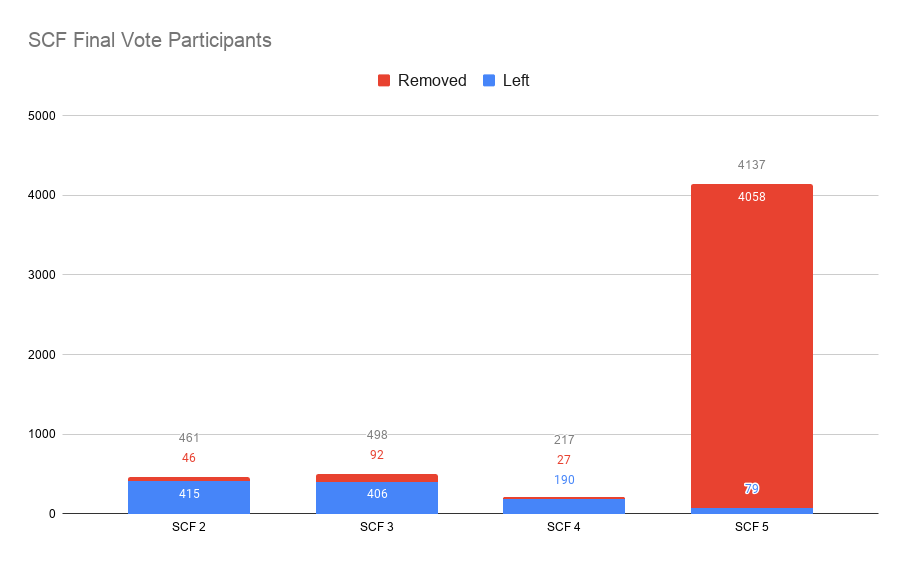
The current system wasn’t designed for that kind of volume, which meant the team spent days and nights combing through thousands of votes and making lots of tough calls. To keep things fair, all accounts with duplicate IPs, zero proofs, inactivity, or bounty hunter proofs were removed. As were accounts created after the nomination voting started. One particularly suspicious project was disqualified, and another two took its place to reflect community sentiment. These were by far the most dramatic steps SDF took to preserve the integrity of SCF, as a decentralized, open, hands-off approach was always preferred. SCF, as it was designed at the time, wasn’t well suited to deal with manipulation of this magnitude.
SCF 2.0 — Lab and Seed Fund and quadratic voting
After five rounds of experience and tons of feedback from participants and voters, the team made some significant changes to SCF. There are two main audiences submitting to SCF, each with a distinct goal for funding: 1) full-fledged companies who are interested in kick-starting development on Stellar, and 2) community developers wanting to get paid for building smaller, more experimental projects and tools. Both are valuable, but treating them the same led to undersupporting the first and overpaying the second: a business can’t get far on $5k, and a tinker project shouldn’t get $50k.
- The Lab Fund with the goal to inspire experimental use cases, open-source software, documentation, events, market presence, and real-world stress tests. Planned to be held four times per year, with 500K XLM being split between ~12 projects.
- The Seed Fund with the goal to help viable, innovative, first-mover businesses and utilities get started on Stellar. Planned to be held two times per year, with 5,000,000 XLM being split between 3–5 projects.
The selection and voting processes also changed. Of all entries, nominated projects would be chosen by a jury of ten randomly selected SDF and community members. With a solid panel of judges electing the best projects, it was deemed safe to open the voter participation floodgates: no more Keybase verification, no more weird caps and limits on votes, just one week of SMS verified voting open to the whole wide world.
A key component of the new community vote was flaggable quadratic voting. Community voting used to be one-dimensional, leaning towards a linear distribution that made it impossible to recognize exceptional projects — either positively or negatively. Implemented by popular blockchain funding programs, including Gitcoin, quadratic voting promises to be better at capturing community sentiment and enables the community to help police bad actors and thwart manipulation.
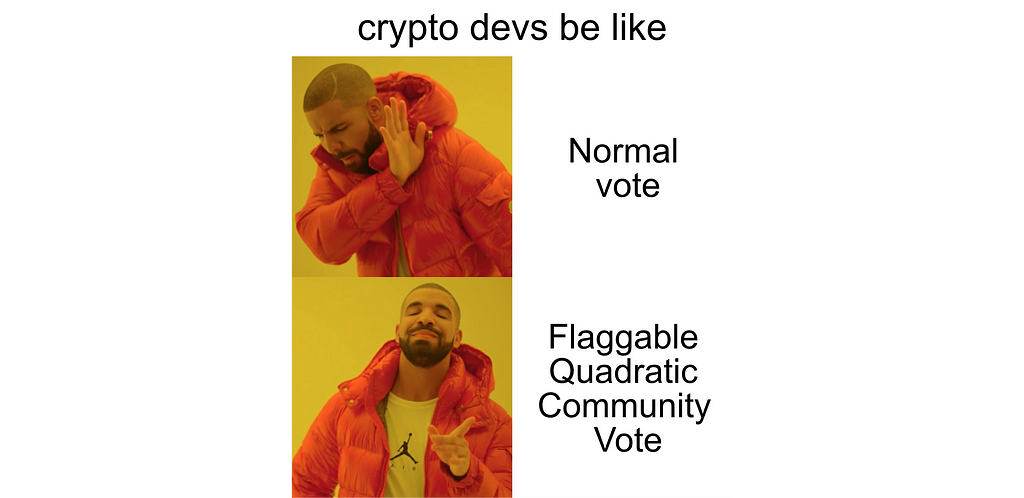
How it worked:
Each voter had 100 credits and could give a max of ten votes for any single project. In addition to upvoting, voters could also downvote a project. The more votes you gave a project, the weight of the vote would increase quadratically:

Voting was live and open, which meant that you could see how many votes a project had already received. If voters suspected foul play, they could use some of their credits to flag an entry and the SDF team would take a closer look.
A new website, communityfund.stellar.org, was also introduced (look at those cute astronauts!). The site contained all SCF rules, including details about each fund and how to submit your project. GalacticTalk was still used sparingly, but the new site was the primary place to see and vote on projects.
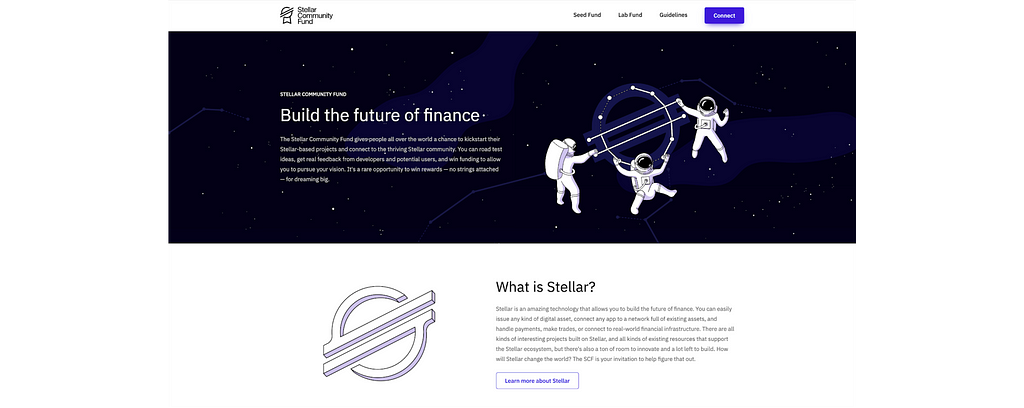
SCF#6 — The Lab Fund for developers to experiment
On August 31, 2020, the Lab Fund (SCF#6) opened for submissions, receiving 19 submissions, of which the jury panel deemed nine finalists ready for participation. While counting the votes it turned out that while the new SMS verification method did slow down bad actors, it couldn’t prevent them entirely: out of the 491 votes, 310 were deemed valid after an objective review.
The new system tracked statistics to get more insight into voter behavior: of the ‘valid’ 310 voters, the average time spent selecting and confirming votes was a mere 90 seconds. Also, the percentage of votes from users who voted for all credits on one project was very high. This indicated that most voters were likely friends and family of the projects who didn’t read the proposals and simply voted for their friend.
The mechanics of flaggable quadratic voting (FQV) produced the intended result of a more logarithmic sentiment distribution versus a stagnant linear one but did nothing to prevent voter manipulation. Also, the inherently complex system was difficult to understand, and many of the ‘real’ voters wondered if they had voted correctly. A lot of time and effort was spent building a complex voting system that did not make much of a difference in the end.
Also, votes were heavily influenced by the number of votes a project had already received. Voters wouldn’t only upvote the projects they liked but also downvote projects that, in their opinion, already had too many votes. While initially seen as essential to express people’s thoughts, many community members questioned the use of ‘negative sentiment’.
SCF#7 — The Seed Fund for businesses looking to scale
Even though we learned a ton in the Lab Fund, the Seed Fund (SCF#7) was a real game changer for SCF history. This fund supported many projects still successful today with hundreds of thousand dollars each. Its first round opened on January 18, 2021, when penny stocks skyrocketed, and the bull market was in full swing. The competition was fierce, with 58 great submissions! It was by far one of the best competitions in terms of the sheer number of high-quality entries.
After two months of deliberation, a panel of 20 judges narrowed the field to eight finalists (not the 3–5 originally planned due to a four-way tie for fifth place). Learning from the Lab Fund, the team made necessary, although unannounced, changes to open up voting to only a select group of SDF and community members (about 50 handpicked at the time). This abrupt decision-making received some pushback but ultimately resulted in a better and fairer approach than all previous SCF rounds.
Each of the eight finalists walked away with $200K-350K worth of XLM, amounts SCF had never given away before, setting the tone for yet another iteration of community funding.
SCF 3.0 — Discord, budget requests, and entrepreneurial focus
After much feedback collection and internal and external discussion, a renewed framework for SCF was born. Tyler officially handed Anke Liu, Program Manager at the Stellar Development Foundation, the SCF baton as he shifted focus to Stellar Quest. Heading SCF’s execution and strategy became one of her key responsibilities.
In contrast of previous SCF rounds, SCF 3.0 focused efforts to other areas besides preventing voter manipulation:
- To ensure projects received a reasonable funding amount based on their project scope, entrants self-select their project budgets in USD (the final payout was still in XLM, but this made budgets easier to reason through).This idea was adopted from a proposal by Nebolsin, a valuable community member.
- Instead of going through nomination and final voting phases, submissions must pass a selection panel before reaching the community, distilling the total amount of submissions to a manageable number for reviewers and voters.
- To build on the voting method of SCF #7, only a select set of community members were able to vote. These individuals are referred to as verified members and need to provide proof of interest in beneficially growing the Stellar ecosystem through an open application. Instead of complicated quadratic voting, voting was simplified to a simple ‘yes or skip’ vote for each proposal and budget: “Does this project deserve the budget it’s requesting?”. To sort any ties, voters could also rank their top three favorites.
- To accommodate smaller and larger projects, entrants could choose from two submission form templates: one more detailed for full-fledged businesses and another more simple for post-hackathon projects.
- Instead of communicating on Keybase, a brand-new Discord server was set up to provide easier community access and organize discussions.
SCF #8 + #9 — Gaining traction
The new changes worked: SCF#8 received 68 submissions and SCF#9 received 80, an increase in 280% from the 2020 SCF rounds!
Before SCF #9’s submission deadline, SDF held two exciting events: 1) the first Blockchain Bootcamp to support Stellar-based fintechs operating in Africa, and 2) a virtual Techstars Startup Weekend Latam with Stellar and Visa aiming to boost innovation in Latin America. The majority of participants in both events applied to the Stellar Community Fund, which led to an increase in diverse participation.
The last two SCF rounds of 2021 funded long-lasting projects including Alfred Pay, GetPaid, Quidroo, Stellar Global, SkyHitz, Tip Me, and xBull Market as well as several SDKs and tools. But you don’t need to win the SCF to gain value- bootcamp participant and previous SCF candidate Stax recently received a Matching Fund Grant of $500k because of their experience! The increase in both quality and amount of submissions wasn’t the only win: Discord helped the SCF become more organized, allowing for more project-specific discussion and feedback conversations, which increased the overall community participation and size. The SCF server grew to almost 1,800 members, a ~235% increase from the ~500 members on Keybase.
SCF #10 — Pitching projects to the community
In February of 2022, submissions for SCF#10 opened. In-person events were officially a thing again, and SDF hosted and sponsored conferences, hackathons, and bootcamps across the globe during the springtime. As a result, 152 companies and developers submitted to SCF #10 and 44 were selected to move forward as candidates. This round introduced Candidate Pitches, where the Stellar community had the opportunity to interact live with candidates during five pitch sessions. Almost all SCF #10 candidates presented their Stellar-based solutions in a matter of minutes, and community members provided support, asked questions, and gave feedback. A new record of community engagement on the SCF Discord!
Since SCF #10 had an unprecedented amount of high-quality projects, the pool amount was doubled from the originally planned 6M XLM to 12M XLM to support the community’s choices. This decision increased the annual award pool to up to 24M XLM, and awards were adaptable to the fluctuating submission quality and amount. After two weeks of deliberation, a panel of 52 judges drawn from both the SDF and the Stellar community and ecosystem voted to award 15 projects their requested budget, awarding a grand total of over 10.5M XLM. Winners included Beans App, The Blue Marble, SmilePay, Sentit, Link, and a set of useful SDKs, tools, and innovative approaches to games, NFTs, and DeFi.
SCF #11 — Renewed guidelines and community-driven bootcamp
During the selection phase of SCF #10, many projects put a lot of work into their submission but were deemed ineligible to participate. In SCF #11, the team worked to improve guidelines to set up future submitters for success, and from that, the SCF Handbook was born: a source of truth document for everything related to the Stellar Community Fund, including all information, rules, and recommendations for project submission and community participation.
Previous bootcamps successfully led high-quality submissions to the SCF, but it was relatively difficult for them to gain popularity with voters, causing some to lose confidence. So in SCF #11, the bootcamp element was integrated into the program, and selected SCF #11 candidates can participate in a virtual bootcamp from November 1–4, 2022. Bootcamp participants will work with SDF and Stellar ecosystem members to define a problem, storyboard a solution, and develop a rapid prototype before getting feedback from the Stellar community.
Since verified members provide critical input and decide how to allocate funding to Stellar-based projects, the team is expanding its efforts to grow, diversify, and engage the verified member panel. Verified members can now join the submission screening selection panel and provide technical and facilitator support in the SCF#11 Startup Bootcamp.
As demonstrated in previous SCF rounds, funding isn’t the only thing candidates walk away with from SCF: the program also unlocks opportunities for continued development and growth. The team will continue to expand efforts to get (select) candidates connected with support from SDF’s Partnerships team, other SDF grants (Marketing, Infrastructure, etc.), and external accelerators, incubators, and investors.
What’s next for SCF

Stay tuned for updates.
If you’ve been part of the Stellar Community for a while and some of what is documented here seems inaccurate, let us know through the SCF Discord or email us at communityfund@stellar.org. We strive to have a complete, candid, and transparent historic overview we can learn from as we work on future iterations of SCF.
The History of the Stellar Community Fund was originally published in Stellar Community on Medium, where people are continuing the conversation by highlighting and responding to this story.

